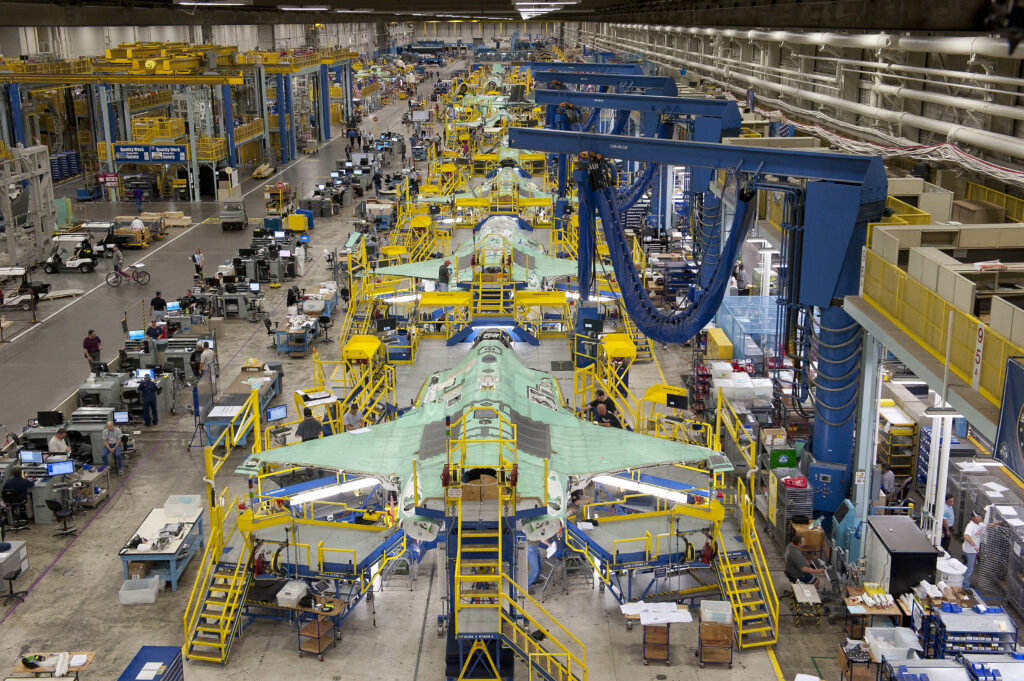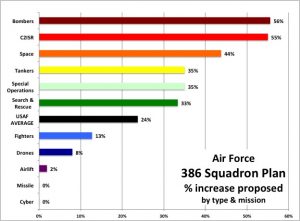Air Force 386 Squadron Plan: Hallucination Or Negotiating Tactic
Posted on

F-35 production line
It looks like the services are lining up for a budget battle royal over the next year as the specter of sequestration again looms. The Navy wants to get to the presidentially-sanctioned goal of 355 ships. The Army wants to build its Big Six. Now the Air Force has declared it can’t do its job well without expanding to 386 squadrons. Mark Cancian, a former senior official in charge of defense budgeting at the Office of Management and Budget, looked at the Air Force’s numbers and used a Force Cost Calculator created by the Center for Strategic and International Studies to figure out how many people, how many planes and how much it may all cost. Want to know how daunting it all looks? Read on! The Editor.
Last week Air Force Secretary Heather Wilson announced “the Air Force we need”, a significant expansion of the Air Force from 312 operational squadrons to 386. The specific rationale for the size of the increase, how it would be accomplished, and what it would cost were not clear. One thing is clear. It will be really expensive. The annual additional cost would be about $37 billion at a time when budget projections show no increase, and up to 94,000 additional personnel, active and reserve.
The chart below shows the Air Force proposal, which Breaking Defense discussed last week. A few quick observations. Much of the growth is in enabling capabilities like tankers, special forces, space, and especially command-and-control, intelligence, surveillance, and reconnaissance (ISR), which provide the precision targeting that long-range munitions require. There is very little growth in RPV/UAVs, which, unless something big is happening in the black world, indicates a renewed emphasis on manned aircraft.
Why is the expansion needed? Gen. David Goldfein, Air Force Chief of Staff, said it’s being driven by the National Defense Strategy: “to defeat a peer threat while being able to deter a near-peer threat … and simultaneously being able to maintain campaign momentum against violent extremism… at a moderate level of risk”. The Air Force says the additional forces are needed primarily for a high-end conflict with China or Russia. The high possibility of severe attrition in battle could be driving the move. The Air Force would need to replace those losses. In previous statements, the Air Force also noted how stretched it was meeting day-to-day requirements for on-going conflicts, crisis response, and allied engagement, so it would not be surprising if that also provided some of the rationale.
How would these reserves be created — buying new planes or using legacy aircraft? Goldfein noted that the Air Force analysis “was a squadron look, not a platform look,” so the Air Force did not specify any numbers for the aircraft required or whether the expansion was, in fact, executable.
Nevertheless, using current Air Force inventory and squadron numbers, it is possible to calculate, at least roughly, the number of aircraft that would be required to implement the proposed expansion. That calculation shows that the Air Force would require a total of about 940 more aircraft to fill the operational units as well as the associated training, maintenance, and test requirements.

BD graphic uses Air Force data
One way to acquire these additional aircraft would be to buy new. However, this is not likely to be possible in the numbers needed along the timelines desired. In the fiscal 2019 president’s budget, for example, the Air Force proposed to procure 100 aircraft of all kinds. It would need to double this production rate to accomplish the expansion by 2028. Without doubling production, the Air Force will need to keep legacy aircraft in the structure longer while it adds new aircraft, perhaps procured at a higher rate to get the expansion needed. It would also need to include the National Guard and Reserve in the expansion, as it likely intends to do.
The Cost
Several years ago, CSIS developed a Force Cost Calculator that takes 120 inputs for force structure, readiness, investment, infrastructure and overhead and calculates the total budget. In making the calculation for forces, it includes all of the direct training and maintenance, as well as indirect support from other units and institutional overhead support. Last summer the team updated the factors for the FY 2018 budget.
Running the Air Force proposal through the Force Cost Calculator indicates an additional cost — once the plan is fully underway — of approximately $37 billion on top of the current $156 billion Air Force budget (excluding funding for the Intelligence Community).
The expansion would require 33,000 additional active duty airmen just for the operational units. Why such a large increase (30 percent) if the force goal only increases by 25 percent? Because the plan proposes large increases to bomber, ISR, and special operations aircraft, which require relatively large numbers of personnel to operate. If support units (like wing headquarters, maintenance, engineer, military police, weather, etc) expanded proportionately to the operational personnel and infrastructure increases, but at a slower rate, the total increase would be 77,000 in the active force. The Guard and Reserve would need 17,000 to fly and support their share of the increase. That total increase would be 94,000.
The Air Force figure of 40,000 is WAY too low, an 8 percent increase in personnel for a 25 percent increase in operational squadrons. It likely includes only operational personnel, that is, personnel in the squadrons themselves without support.
Recruiting and retaining these large numbers would be challenging, even for the Air Force, which traditionally has had the easiest time in this area. Most challenging, however, would be acquiring the additional pilots. Of the 940 additional aircraft needed, about 850 would be in flying units (operational, training, test). That would require another 2,500 pilots or so. But the Air Force is already 2,000 pilots short, so the Air Force would face the prospect of aircraft without pilots. To be fair, the Air Force would have a decade to fix this problem and is working hard to narrow the gap, but such a large expansion would greatly raise the bar.
Optimism, Hallucination or Negotiating Tactic?
The budget skies ahead are stormy. DoD’s budget projections are flat in constant dollar terms. That means that any new initiatives must be offset by cuts elsewhere. Deputy Defense Secretary Patrick Shanahan has said that the department will find management efficiencies but, beyond some information-technology consolidations, none have yet been reported.
The Air Force could try to grab budget share from other services, but they have their own needs and will hang on to their funding tightly. The Navy aims to expand to 355 ships, and they have the advantage of having presidential support for that expansion, something the Air Force now lacks.
It’s not clear that the Air Force will even get the funding it currently assumes. The makeup of the Congress may change in the midterm elections in November, and the Democratic Party has been moving to the left. Recently, Rep. Adam Smith, the ranking minority member of the House Armed Services Committee, warned: “I think the [$716 billion fiscal year 2019 defense topline] is too high, and it’s certainly not going to be there in the future.” That’s a change from the bipartisan support of defense increases that have been evident in the last few years.
Of course, none of this may be relevant. The expansion goal may just be the Air Force’s way of expressing its true needs and strengthening its position for the inevitable strategy and budget controversies ahead. It may not represent a “plan” at all, but a negotiating position to counter the Navy’s 355 ship goal. (Note to Army: what’s your goal?).
So, “the Air Force we need” enters the DoD planning process for fiscal 2020. The 2020 budget, published next February, will show what, if anything, emerges from that process. The plan’s details will be revealed in the spring, and with them, we’ll have something specific to analyze. Stay tuned.
Subscribe to our newsletter
Promotions, new products and sales. Directly to your inbox.
